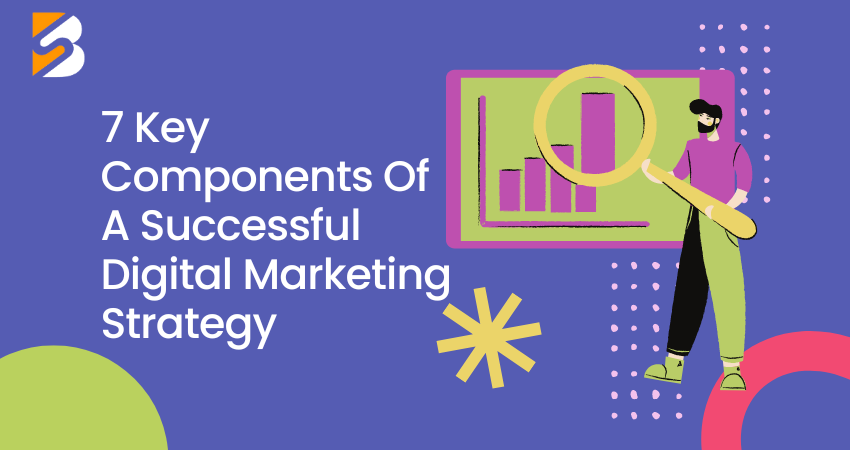Digital marketing is a broad term that encompasses a variety of online marketing activities, such as search engine optimization (SEO), pay-per-click advertising (PPC), social media marketing, and email marketing. A successful digital marketing strategy will use a combination of these activities to reach your target audience and achieve your marketing goals.
However, by understanding and implementing the key components of a successful digital marketing strategy, businesses can harness the power of the digital landscape to reach their target audience, generate leads, and drive conversions. In this blog post, we will explore seven essential components that form the foundation of a thriving digital marketing strategy
7 Pillars of Digital Marketing Success
A well-crafted digital marketing strategy is essential for businesses seeking to thrive in the digital landscape. Here are the seven key components that contribute to a successful digital marketing strategy:
Clearly Defined Goals
The first step in building an effective digital marketing strategy is setting clear and measurable goals. Whether it’s increasing branding, driving website traffic, or boosting sales, your goals should align with your overall business objectives. By establishing specific, realistic, and time-bound goals, you can track progress, make data-driven decisions, and ensure your digital marketing efforts are aligned with your business’s long-term vision.
Target Audience Analysis
Understanding your target audience is vital for crafting a successful digital marketing strategy. Conduct thorough market research to identify the demographics, preferences, and online behaviors of your ideal customers. This information will enable you to tailor your marketing messages, choose appropriate channels, and engage with your audience effectively. Utilize tools such as Google Analytics, social media insights, and customer surveys to gather valuable data and refine your audience personas.
Compelling Content Strategy
Compelling content lies at the heart of digital marketing success. Develop a robust content strategy that delivers value, engages your audience, and builds trust. Create a content calendar outlining the types of content you will produce, such as blog posts, videos, infographics, or social media updates. Ensure your content aligns with your audience’s needs and preferences, incorporates relevant keywords for search engine optimization (SEO), and encourages social sharing to maximize its reach and impact.
Search Engine Optimization (SEO)
SEO plays a crucial role in improving your website’s visibility in search engine results. By optimizing your website’s structure, content, and technical aspects, you can attract organic traffic and increase your online presence. Conduct keyword research to identify the terms your target audience is searching for and incorporate them strategically into your website’s content. Enhance your website’s user experience, improve page load speed, and build high-quality backlinks to boost your search engine rankings.
Social Media Marketing
Social media platforms provide a vast opportunity for businesses to connect with their audience, increase brand awareness, and drive traffic to their websites. Identify the social media channels where your target audience is most active, and create engaging profiles on those platforms. Develop a social media strategy that includes regular posting, audience interaction, and content promotion. Leverage paid advertising options on platforms like Facebook, Instagram, or LinkedIn to reach a wider audience and amplify your marketing efforts.
Email Marketing
Email marketing remains a powerful tool for nurturing leads, building customer relationships, and driving conversions. Develop an email marketing strategy that includes capturing leads through website opt-ins, segmenting your audience based on their interests, and delivering personalized and relevant content. Create compelling email campaigns, such as newsletters, product updates, or exclusive offers, and track open rates, click-through rates, and conversions to optimize your email marketing efforts.
Analytics and Measurement
To gauge the effectiveness of your digital marketing strategy, it’s crucial to implement robust analytics and measurement tools. Utilize platforms like Google Analytics, social media analytics, and email marketing software to track and analyze key metrics such as website traffic, engagement rates, conversion rates, and ROI. This data will provide valuable insights into the performance of your campaigns, enabling you to make informed decisions, refine your strategies, and allocate your resources effectively.
In addition to the seven key components listed above, there are a few other things you can do to improve your chances of success with digital marketing. These include:
- Use a variety of marketing channels. Don’t rely on just one marketing channel to reach your target audience. Use a variety of channels, such as SEO, PPC, social media, and email marketing, to reach as many people as possible.
- Be patient. Digital marketing takes time to see results. Don’t expect to see a huge increase in traffic and sales overnight. Be patient and consistent with your efforts, and you will eventually see results.
- Get help from a professional. If you don’t have the time or expertise to develop and implement a successful digital marketing strategy, you can hire a professional to help you. A good digital marketing agency can help you develop a strategy that is tailored to your specific needs and goals.
Conclusion
Crafting a successful digital marketing strategy requires careful planning, analysis, and adaptation. By incorporating these seven key components – clearly defined goals, target audience analysis, compelling content strategy, SEO, social media marketing, email marketing, and analytics – you can establish a strong foundation for your digital marketing efforts. Remember to continuously monitor and evaluate your campaigns, staying abreast of industry trends and evolving customer behaviors. With a well-rounded digital marketing strategy, your business can thrive in the ever-changing digital landscape and achieve its goals.



